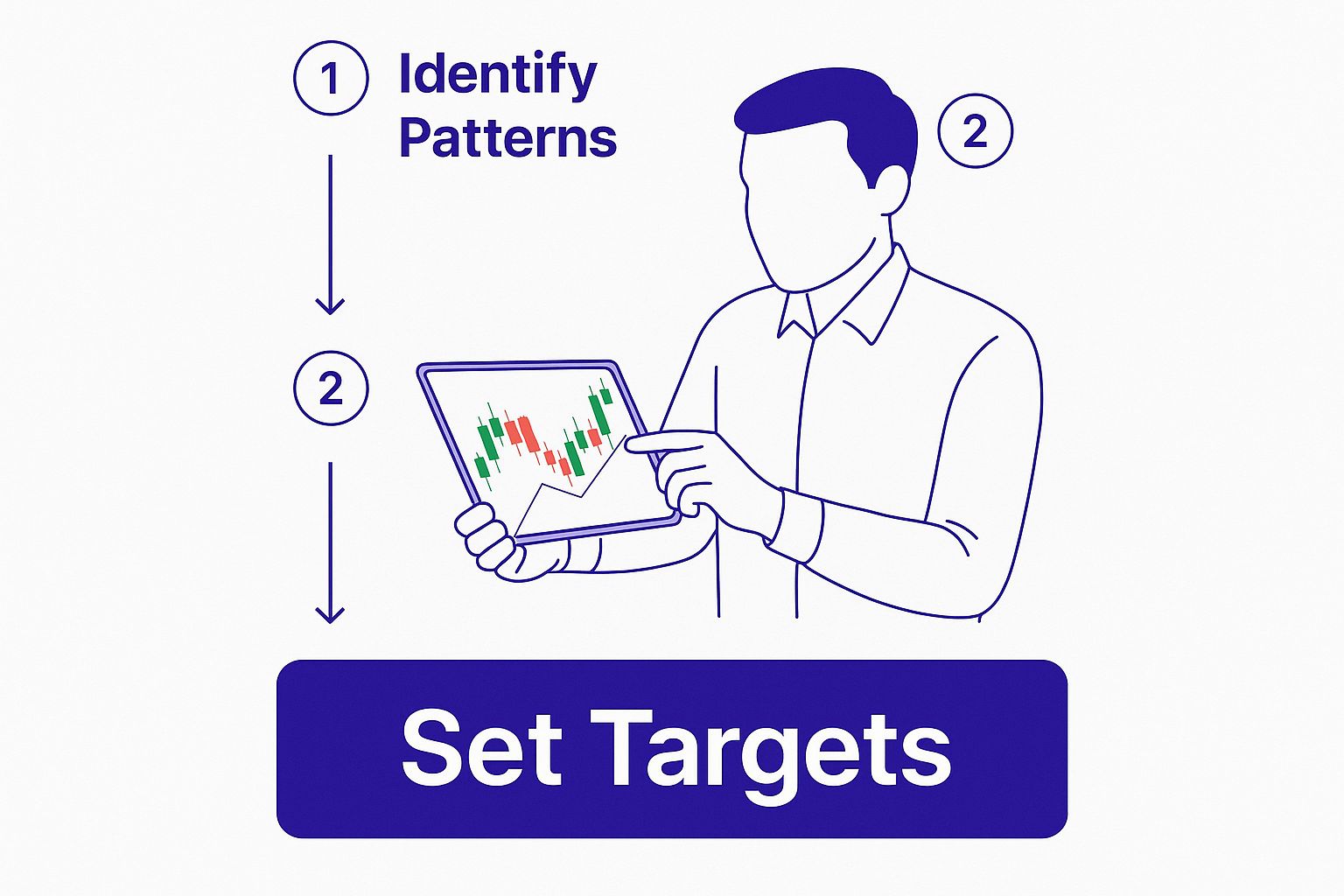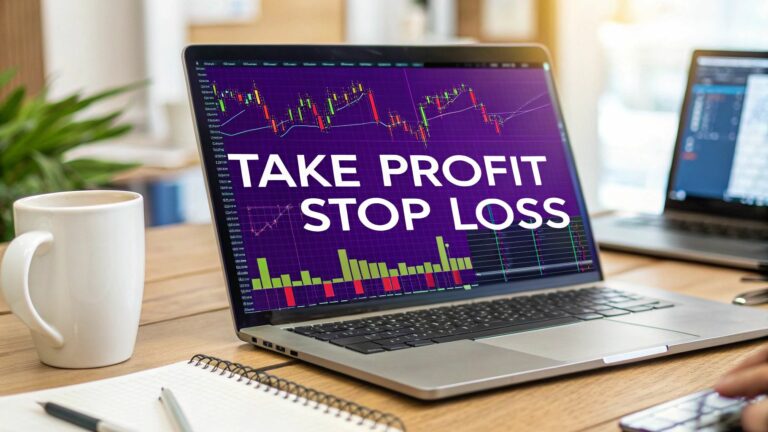Before you even think about placing a trade, you need an exit plan. That’s where the take profit stop loss combination comes in. These aren’t just fancy terms; they're the automated orders that form the backbone of any serious trading strategy.
Think of it this way: one order locks in your profits when you're right, and the other cuts your losses short when you're wrong. Together, they are the twin pillars of disciplined trading.
Take Profit vs Stop Loss at a Glance
To really get a handle on this, let's break down what each order does. They might sound similar, but their jobs are polar opposites.
| Order Type | Primary Goal | When It's Triggered | Psychological Benefit |
|---|---|---|---|
| Take Profit (T/P) | Secure profits | When the price reaches a pre-set higher target | Prevents greed from turning a winning trade into a loser |
| Stop Loss (S/L) | Limit losses | When the price hits a pre-set lower point | Protects capital and prevents catastrophic losses from fear or hope |
Having both in place gives you a massive psychological edge, allowing you to stick to your plan even when the market gets chaotic and your emotions are running high.
Why the Pros Swear by Automated Orders
Ever wonder how professional traders seem to execute their plans with such consistency? A big part of their secret is a strict reliance on automated orders. By setting their exit points before they even enter a trade, they completely sidestep the temptation to make impulsive, emotional decisions.
This is non-negotiable in volatile markets like Forex, where prices can swing wildly in seconds. The Forex market is a beast, trading 24 hours a day with a global turnover exceeding $7 trillion. Navigating that kind of environment without a safety net is a recipe for disaster. As TIOmarkets explains in their guide on order management strategies, these orders are indispensable.
A trading plan without a take profit and stop loss is just a wish. These orders transform your strategy from a hopeful guess into a defined, repeatable process with clear risk parameters.
Ultimately, using a take profit stop loss setup is how you put the classic risk-to-reward principle into practice—and that’s the foundation of any trading approach built to last. By mastering these tools, you create a solid framework for every single trade.
If you're ready to dig deeper and sharpen your skills, check out the resources waiting for you in our vTrader Academy.
Placing Your Orders in vTrader
Knowing the theory is one thing, but making it happen is where the rubber meets the road. Luckily, vTrader bakes your exit strategy right into the order process, so you’re managing risk from the moment you enter a trade.
When you pull up the order entry window, you’ll find dedicated fields for both take profit and stop loss. Forget placing separate orders; it's an all-in-one deal. You just punch in your target prices before you hit execute. This works for market and limit orders, making it a flexible part of any entry plan.

The real takeaway here is that great trades start with a solid plan rooted in market analysis—not just a gut feeling.
Setting Orders on New and Existing Trades
For a brand-new position, the process is clean and straightforward. Bundling your entry with your exits in a single move is easily the most efficient way to operate. This simultaneous setup also means that once your take profit or stop loss gets hit, the other is automatically cancelled. No more worrying about forgotten orders lingering in the market.
But what if you're already in a trade and forgot to set your exit points? Don't sweat it. You can add a take profit stop loss order to any open position.
- First, head over to your open positions tab in vTrader.
- Find the trade you need to manage and select it.
- You'll see an option to "Add TP/SL," which will open up the fields to input your price levels.
This is a smart feature that encourages disciplined trading on every single move. By making it simple to lock in these critical orders, vTrader helps protect your capital from nasty surprises and lets you methodically bank your profits.
Where to Set Your Profit and Loss Levels
Anyone can slap a take profit stop loss order on a trade. But where you place it is often what separates a profitable trader from one who’s just guessing. It's about moving beyond random percentages and using technical analysis to find exit points that actually make sense.

Think of your stop loss this way: it should be at a price that completely invalidates your entire reason for opening the trade in the first place. One of the most solid techniques is using support and resistance levels. If you’re going long (buying), it makes a world of sense to tuck your stop loss just below a recent support level. If the price crashes through that floor, your trade idea was probably wrong.
Conversely, if you're shorting (selling), you’d place that stop just above a clear resistance ceiling. This simple trick anchors your risk to the market's actual structure, not just some arbitrary number you pulled out of thin air.
Using Indicators for Smarter Placement
To really sharpen your edge, you'll want to adapt to the market's mood swings. This is where the Average True Range (ATR) indicator comes in. The ATR measures volatility, giving you a dynamic value to work with.
For instance, if the ATR for an asset is $0.50, you could set your stop loss at 2x the ATR ($1.00) below your entry point. This gives your trade more breathing room in choppy markets and tightens things up when the market is calm, helping you avoid getting knocked out by normal price fluctuations.
When it comes to take-profit targets, you’re hunting for logical spots where the price is likely to run out of steam and reverse.
- Previous Highs or Lows: A classic move. For a long trade, setting your take-profit just below a significant recent high is a high-percentage play.
- Fibonacci Levels: Fibonacci retracement and extension levels are a favorite among traders for spotting potential reversal zones that make for fantastic profit targets.
The goal is to let the market itself tell you where to get out. A stop loss grounded in a support level and a take-profit target near a resistance level gives your trade a clear, logical framework.
Another powerful approach is to define your exits with a strict risk-to-reward ratio. Let's say your stop loss represents a 1% risk to your capital. A 1:2 risk-to-reward ratio means you’d set your take-profit target at a level that banks a 2% gain. This method builds discipline and ensures your wins are big enough to justify the risks. Many traders find this boosts long-term profitability, much like investors explore different avenues for portfolio growth. While you're actively trading, you can learn more about how staking rewards offer a different way to grow your portfolio on vTrader.
Protecting Profits with Trailing Stops
So, your trade is in the green—fantastic! Now comes the tricky part: how do you let those profits run without giving them all back if the market suddenly turns on you? This is exactly where a trailing stop becomes one of the most powerful tools in your trading toolkit.
Think of it this way: a normal stop loss is static, stuck at one price. A trailing stop, on the other hand, is dynamic. It intelligently "trails" the market price by a specific distance you set, but only when the trade moves in your favor. This clever setup lets you lock in gains as they happen. If the price goes up, your stop loss moves up with it. If the price falls, your stop stays put, creating a safety net to protect the profits you've already made.
The Power of Dynamic Protection
A trailing stop truly shines when you catch a strong, sustained trend. Imagine you bought an asset just as it started a massive rally. A standard take profit stop loss would likely cash you out way too early, leaving a ton of potential profit behind. A trailing stop, however, lets you ride that trend for every last drop.
Of course, they aren't a silver bullet. The biggest risk is getting stopped out too soon by normal market chop. In a market that’s trending up but with plenty of bumps along the way, a minor dip could hit your trailing stop and kick you out of a position that was about to soar. The real skill is finding that sweet spot for the trailing distance in vTrader—not so tight that market noise takes you out, but not so wide that you hand back a huge chunk of your profits. Nailing this balance often just comes with screen time and experience.
Trailing stops are the ultimate blend of defense and offense. They protect your capital like a traditional stop loss while giving your winning trades the room they need to run. It's an automated way to keep both greed and fear in check.
It’s not just theory, either. Historical analysis often shows trailing stops coming out ahead of static ones. One study that looked at 11 years of equity market data found that a trailing stop strategy at a 20% level delivered 27.47% higher returns than a fixed stop. You can dig into these stop loss performance findings on quant-investing.com yourself.
Just remember that the constant adjustments from a trailing stop can affect your trading costs over time. It's always a smart move to review vTrader’s fee structure and make sure your strategy is as cost-effective as it is profitable.
Common Mistakes and How to Avoid Them
Even with a solid take profit stop loss strategy in hand, a few classic mistakes can completely derail your efforts. It's one thing to know what these orders do, but it's another thing entirely to sidestep the psychological traps and execution blunders that chew away at a trader's capital.

I’ve seen it countless times: a trader sets their stop loss way too tight. They place it just a few ticks from their entry, and the market’s normal, everyday "noise" knocks them out of a perfectly good trade. Moments later, the price moves exactly where they predicted it would. It’s a gut-wrenching experience, and it's completely avoidable.
The opposite mistake is just as dangerous—setting your take profit target with a dose of pure fantasy. Sure, aiming for the moon feels ambitious, but placing that order miles from the current price often means you'll watch a profitable trade reverse and turn into a loss before it ever gets close.
The Cardinal Sin of Trading
But the absolute worst mistake? Manually dragging your stop loss further down when a trade starts going against you. This is the cardinal sin of trading. It’s not risk management; it’s an emotional decision fueled by hope, and it’s exactly how small, acceptable losses balloon into account-crushing disasters.
Your stop loss is your pre-committed exit plan, not a suggestion to be debated when you're under pressure. Once it's set based on sound analysis, let it do its job.
Sticking to your plan is non-negotiable. Clustered stop orders can even create their own volatility. Research from the Federal Reserve Bank of New York has highlighted how a heavy concentration of stops around a specific price can trigger a cascade effect, leading to sudden, sharp price moves. You can dive deeper by exploring their findings on price cascades and market volatility.
To steer clear of these common pitfalls, here's what to focus on:
- Give Your Trades Room: Use tools like the Average True Range (ATR) to set stops outside the zone of typical market chatter.
- Set Attainable Goals: Place your take profit orders near logical resistance levels or previous highs, not just at a fantasy price.
- Stick to the Plan: This is the big one. Never, ever widen your stop loss on a losing trade.
By understanding these common errors, you can start building the discipline needed to trust your initial analysis. For more timely insights into market dynamics, you can always check out the latest updates on the vTrader news hub.
Frequently Asked Questions
Even the most seasoned traders have questions when it comes to dialing in their take profit stop loss orders. It's a constant balancing act. Here are a few of the most common queries we see and the straight answers you need.
Should I Use a Take Profit Order on Every Trade?
This is a great question, and the answer really gets to the heart of trading psychology and strategy. While a stop loss is pretty much non-negotiable for smart risk management, take profits are more of a strategic choice.
Many traders swear by them. Setting a take profit enforces discipline, plain and simple. It helps you systematically lock in your gains at a target you set before emotions kicked in. This is your best defense against greed, which can easily turn a solid winner into a loser if you hold on too long.
On the flip side, some strategies, especially those built around riding long trends, actually skip fixed take profit orders. These traders prefer a trailing stop to let their winners run, hoping to catch a massive move without putting a ceiling on their potential. Ultimately, it comes down to your personal trading style and what the market is telling you.
Can I Adjust My Orders Once a Trade Is Live?
Absolutely. Not only can you, but you often should. Once a trade moves nicely in your favor, it's a common and wise practice to slide your stop loss up to your entry price (breakeven). This takes the risk off the table and protects your original capital. Even better, you can move it into the green to lock in a small profit, no matter what happens next.
The one thing you should never, ever do is move your stop loss further away to give a losing trade more room. That’s not strategy; it’s hope. It's a classic emotional blunder that blows up accounts.
You can also adjust your take profit, but be careful. Make sure you have a logical, data-driven reason for it based on new market information—not just a gut feeling that you can squeeze out a few more dollars.
What Is a Good Risk to Reward Ratio?
You’ll often hear traders talk about a 1:2 risk-to-reward ratio as the gold standard. That means for every $1 you're willing to risk, you're aiming to make at least $2 in profit.
But there's no magic number that works for everyone. The "best" ratio is completely dependent on your strategy's win rate. If your strategy wins a high percentage of the time, you can be profitable even with a 1:1 ratio. Conversely, if your strategy has fewer, but larger, wins, you'll need a higher ratio like 1:3 or even more to stay ahead over the long haul.
For more answers to your trading questions, be sure to explore our detailed vTrader FAQ page.
Ready to trade with confidence? Join vTrader today to access advanced tools, zero-fee trading on major cryptocurrencies, and a full suite of educational resources to sharpen your skills. Sign up now and start building your portfolio.

Steve Gregory is a lawyer in the United States who specializes in licensing for cryptocurrency companies and products. Steve began his career as an attorney in 2015 but made the switch to working in cryptocurrency full time shortly after joining the original team at Gemini Trust Company, an early cryptocurrency exchange based in New York City. Steve then joined CEX.io and was able to launch their regulated US-based cryptocurrency. Steve then went on to become the CEO at currency.com when he ran for four years and was able to lead currency.com to being fully acquired in 2025.


